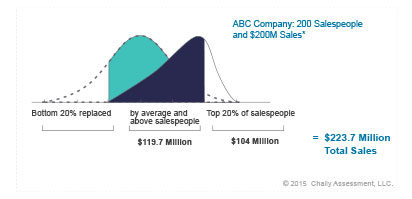Does Spending a lot to Duplicate Your “A” Sales Players Work?
One of the favorite consultants’ solutions to building sales force productivity goes like this: Study and identify the techniques of your “A” sales players, your superstars (the top 20%). Then, train the rest to use these winning techniques. They typically offer case studies and examples. So, let’s test this sales myth with a little common sense and basic sales math.
Our test dummy here is a very typical 200-person sales force for a company (ABC Company) that has annual sales of $200 million (let’s keep it simple). If we plot the normal bell-shaped curve, the basis for the famous “80/20 rule” cited so frequently to describe typical sales force productivity, it would look like this:

Myth one: However, contrary to the popular 80/20 expression, the top 20% (our “a” sales players) of our sales force does not deliver 80% of all sales, but 52% is still pretty good. So, let’s study the techniques of the top 20% and train the middle 60%. Additionally, let’s assume we could get an aggressive 5% improvement from training. What growth can we expect? The Result:

Improving the performance of the middle 60% by an aggressive 5% each can only produce a 2.25% improvement in sales. It’s likely that the Superstar benchmarking research and training cost at least several hundred thousand dollars. Myth conclusion: This myth’s hardly worth it!
Be Merciful: LOSE THE LOSERS. So, what would the smart money do to grow sales? The people who make it to the “C” suite (and succeed there)? They’d apply Total Quality Management (TQM) principles (e.g., focusing on finding and eliminating the sources of sales failure, the basis for six sigma, ISO and “Lean” productivity improvements). They’d focus on the real problem with this sales force – The bottom 20%! Those who are losing all the money!
Reassigning or replacing the bottom 20% with just “average” salespeople will increase production by a minimum of 9%. If you now train the rest of the sales force and get a 5% gain, you get an additional $5.7 Million.
By the way, for those sales managers who would rightly be concerned that we can’t leave that many territories open by firing all of the bottom salespeople, take heart. The global statistics indicate that on average, half of all the bottom 20 percenters leave their organizations voluntarily every year. They realize this job is worse for them than the company does.

The Bottom Line
Replacing the myth with real math, common sense, and a little Total Quality Management thrown in costs less and grows productivity by 19.3 million more. In fact, applying TQM to sales or TQSalesM™ as a continuing process produces even more dramatic results.

Start your TQTalentM process by performing a Talent Audit, which will give you an inventory of all competency strengths and development opportunities.


